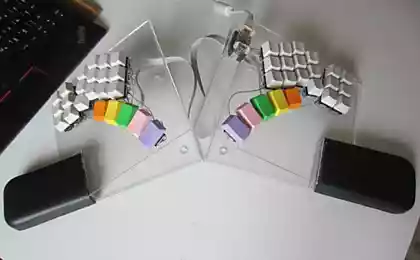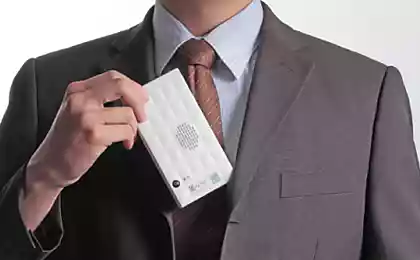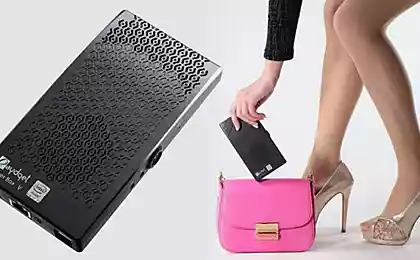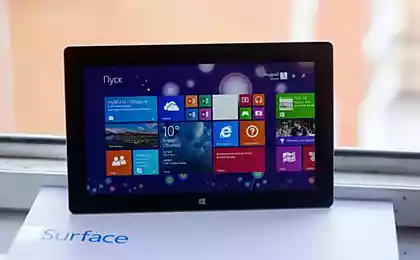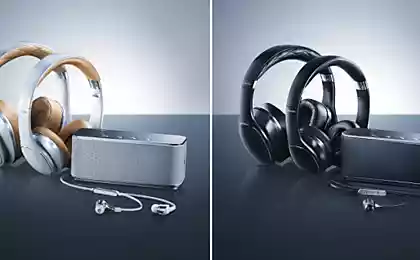Tactile feedback is present in the gadget is already a very long time. Most often it is presented in smartphones and joystick game consoles in the form of "vibrating alert" and sympathetic vibration in response to user actions. Duplicate incoming calls, reminders, and shake when shooting and explosions, are the most common uses of the tactile function. And the vast majority of users do not imagine other ways to use this link.
However, there are several areas of use of this method of interaction and receiving information from the devices. More specifically, these three directions. And they are widely used in electronics outlets will give users a new experience of using the usual seemingly gadgets. This will mark the beginning of a new stage in the development of consumer devices, aptly named «
neosensornoy era ».
The first method is the application of tactile feedback - expanding the range of tactile sensations from the use of gadgets. The second way - to send a specific template information. The third way - communication. Let us consider each of them in detail.
Expanding the range of tactile sensations h4> Recently Amazon has released five new devices, two-reader e-ink tablet three. And the most interesting device is an eReader premium Kindle Voyage.
Than it is notable? On both sides of the screen whose surface texture reminiscent of paper are touch zone for page turning. It goes Flipped initiated not familiar touch or gesture of sliding, and light compression these sensory areas. When "flips" page, accompanied by a vibration device, similar to the one that occurs when sliding paper pages each other.
Incidentally, in the first YotaPhone we also experimented with tactile feedback when using the touch zone under the second screen. When flipping pages gesture sliding smartphone vibrates nicely. The second will be fully touch YotaPhone second screen, which gives much more flexibility. Therefore developed a completely new scenario using the second screen, which you will find after the presentation of the smartphone.
Another example of a new approach to the use of tactile communication demonstrate Apple iWatch, which will go on sale next year. They are integrated into the so-called «Taptic engine» (combination of words tap i> (touch) and haptic i> (tactile)), a unique system of physical response to user actions. For example, when you turn the head "factory", I immediately feel a particular vibration, as if dancing on your wrist that adds unusual sensations while using this mechanical control. When you swipe your finger across the screen, press the button next to the head, or perform some other action, Taptic engine generates specific responses tactile response, accompanied at feeling
Do not stand aside from a new direction and a sworn friend Apple, Samsung. Koreans have recently presented a series of multifunction printers Smart MultiXpress , equipped with "tablet" interface with a variety of tactile communication.
All these above mentioned devices take advantage of the new trends in engineering, called haptography i> ( haptic i> + photography i>, can be translated as "taktilografiya"). It involves the registration and recording of physical sensations with subsequent reproduction. In fact, this trend is in the very beginning of its formation. With its further development, users will be available a new dimension in interaction with gadgets. For example, we will be able to feel the texture of the surface of the items that we see on the screen or heard from the speaker. Modern lifeless displays of smartphones and tablets will come alive, will literally respond to touch. All types of interfaces on the car dashboard to refrigerator doors and remote controls will be "touch response" to our touch. And this tactile "responsiveness" will fascinate practically.
The transfer of specific information template h4> In Apple iWatch watch also has a mechanism to transfer a specific template information. For example, if you go on the route, laid in a mapping application, the watch will alert you of the need to turn the vibrating right or left side, so you do not even have to look at the screen.
New hybrid car Mersedes S550 will transmit tactile information by vibration floor underfoot driver . For example, the machine will thus prompting the need to slow down the gas to fuel savings or battery life. Another type of vibration of the driver notified of switching from electric to ICE.
Handheld devices like smart glasses (which, unlike the products Google, will look like regular glasses) will slightly vibrate, alerting the user to the contact in the field of view of any particular information.
Community h4> Perhaps the interaction with people - is one of the most interesting ways to use tactile feedback. And here again we have to mention Apple iWatch. If you choose to contact someone from your favorites list, and then touch the screen, that this person will feel it touch through its instance-specific vibration Apple iWatch. You can even send your heart to another person, with the sender and the recipient will see on the screen pulsing heart, and both will feel his rhythm on his wrists. By the way, perhaps in the Russian language will eventually turn a vocabulary like "smell hours».
This idea is used in many startups, such as a bracelet Tactilu , which conveys "touch" from one user to another.
Of course, this property will soon be introduced in smartphones. Perhaps even reaches to the standardization of a "tactile protocol." Surely there will be custom vibroskhemy, by analogy with the melodies for calls and SMS, so you can see who is calling you, just on a specific vibration, selected for this contact.
The most amazing thing in this perspective is not indulging lazy users who do not want to even look at the phone screen, and a new psychological experience, something resembling telepathy when you, in the first moments, even unknowingly, suddenly "feel" the attention of another person. < br />
How tactile feedback improves user experience h4> We now stand at the very beginning "neosensornoy era." It is very likely that in a couple of years in the vast majority of gadgets will be integrated function extremely plausible tactile feedback. We find ourselves in a situation where user expectations will encourage manufacturers to integrate high-quality tactile interfaces to all the new gadgets.
Vividly new trend will manifest itself in the portable gadget. It is possible that there will be devices that do not will have no interface, except for tactile - no sensory-graphic or mechanical. Such interfaces will add a kind of depth and completeness, in the literal sense, a good sense of computers, phones, tablets and handheld devices, including cars and various household appliances. In part, this will give a purely utilitarian advantages, but mostly we will attract exactly the psychological, aesthetic moment.
And if all sorts of types of vibration add change in surface texture gadget ? Do not just get some active response to their actions, it is fully possible to characterize as "skin feel."
Perhaps the greatest variety of applications tactile feedback will be observed exactly in smartphones, simply because of their versatility and constant demand of users.
Imagine you are watching a movie, the scene in the desert, and your smartphone becomes as if made of compacted sand. Or your loved one will write to you that touch the glass of the window, and you start to feel the smoothness and firmness of its surface. Paper, wood, glass, concrete, sand, all this can be not just a "touch", our brain will get much more information about the situation, and almost unconscious level we are much more deeply understand and empathize with other people, subjects of books, movies, games , television news, even the songs.
Interesting prospects open to users, leading an active correspondence on smartphones. For different users in the contact list, social networking and instant messengers can customize not only different vibroskhemy, but also changes the texture of the surface. And typing a message to someone, you do not need to be distracted, to see who you've already written. Different tactile scheme can be created even for different emoticons, passing thus feeling smiles and laughter, sadness, anger and many other emotions.
It is very likely that may appear interchangeable panels for smartphones, hard or as soft slim-fitting covers that can be changed for another texture of its surface. Naturally, they will YotaPhone completely transparent, allowing you to work with touch screens. Thus vibroskhemy may be different depending on which screen YotaPhone you are currently working with. Real freedom for kinestetikov-gourmets.
There will be programs that allow you to create your own algorithms vibroskhemy and texture changes. And if today we show each other photos taken on a smartphone, it is possible that in 15 years we will offer each other just hold them.
Do not be surprised if many users will subconsciously perceive their smartphones as living pets, because they will not only be responsive to our actions, but also to show "their own emotions."
We believe that two decades most of the gadgets and devices will be equipped with tactile user interfaces. At least we hope so very much.
Source: habrahabr.ru/company/yotadevices/blog/238639/
